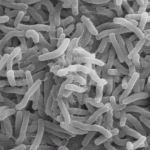Microbiology
|
15 october 2014 06:05:01 |
| In vitro combination therapy using low dose clotrimazole and photodynamic therapy leads to enhanced killing of the dermatophyte Trichophyton rubrum (BMC Microbiology) |
|
Tweet Background:
Superficial infections of the skin and mucous membranes caused by dermatophyte fungi are amongst the most common and challenging infections to treat. Previously we demonstrated the phototoxic effects of photodynamic therapy (PDT) towards Trichophyton rubrum, using a green laser to photoactivate Rose Bengal (RB). The aim of this study was to evaluate whether we could; (1) achieve a similar effect using an inexpensive light-emitting diode (LED) to photoactivate RB and (2) to evaluate whether our PDT regime could be combined with standard antifungal drug therapy and increase its effectiveness.
Methods:
We designed and built our own inexpensive green (530?nm) LED source and tested its efficacy as part our RB-PDT regime in vitro against T. rubrum. We also examined the potential benefits of incorporating PDT as part of combination therapy and whether the order in which this was done had an impact. First we subjected spore suspensions to sub-inhibitory concentrations of a number of antifungal agents (CLT, MCZ and TRB) for 72?hours followed by RB-PDT. Secondly we subjected spore suspensions to sub-inhibitory PDT followed by drug treatment and evaluated if there were any changes to the minimum inhibitory concentrations (MICs) of the drugs tested.
Results:
The optimal conditions for photoinactivation of T. rubrum using RB-PDT alone were 140??M of RB and 24?J/cm2 of LED (equating to a 30-minute exposure). These parameters also caused a 100% reduction in the viability of the pathogenic yeast Candida albicans and the model fungus Saccharomyces cerevisiae. By combining our RB-PDT regime as an adjunct to antifungal drugs we were able to dramatically reduce the exposure times. Treatment of spore suspensions using a sub-inhibitory dose of clotrimazole (CLT) followed by RB-PDT, this order was critical, significantly reduced the exposure times required to achieve 100% inhibition of T. rubrum to 15?minutes as compared to RB-PDT alone.
Conclusions:
The combination of antifungal drug and RB-PDT represents an attractive alternative to the current antifungal therapies used to treat superficial fungal diseases. Our approach has the potential to reduce treatment times and drug dosages which can also reduce drug toxicity and improve patient compliance. |
| 107 viewsCategory: Microbiology |
 Identification of glycoproteins secreted by wild-type Botrytis cinerea and by protein O -mannosyltransferase mutants (BMC Microbiology) Identification of glycoproteins secreted by wild-type Botrytis cinerea and by protein O -mannosyltransferase mutants (BMC Microbiology)Viral infection: KSHV flicks the metabolic switch (Nature Reviews Microbiology) 
|
| blog comments powered by Disqus |
MyJournals.org
The latest issues of all your favorite science journals on one page
The latest issues of all your favorite science journals on one page



